Introduction: Blogbuster vs Jasper AI in 2025
Long-form, SEO-driven blogging still wins in 2025. To grow sustainably, teams need AI that balances speed, quality, and search visibility - without drowning creators in busywork. This AI writing tools comparison focuses on how Blogbuster and Jasper AI perform where it matters for ranking and scale: long-form depth, SEO features, workflow automation, collaboration, integrations, and pricing.
What we compare in this guide:
Long-form depth: outline control, factual depth, and document structure for 2,000–3,000+ word posts
SEO features: on-page optimization, keyword support, internal links, and integrations
Workflow and automation: templates, scheduling, CMS connections, and publishing
Collaboration and governance: brand consistency, roles, and review flows
Integrations and extensibility: native connections and APIs
Pricing: starting points and scale considerations
Quick note: if you need a full blog platform that combines AI writing with hosting, analytics, and newsletters, consider a platform-level solution like BlogBowl, which we cover in the conclusion as an alternative for end-to-end publishing.
Comparison at a Glance (Key Differentiators)
Snapshot: Blogbuster is purpose-built for SEO blogs at scale with auto-internal links and backlink exchange; Jasper AI is a broader marketing AI platform focused on brand-safe creation and complex team workflows.
Long-form: Both handle long-form; Blogbuster emphasizes blog structure (tables, lists, on-page meta); Jasper provides a robust editor with brand voice and marketing context.
SEO: Blogbuster includes keyword/topic suggestions, internal linking, and automated backlinks; Jasper emphasizes brand and marketing context, with SEO supported via workflows and extensions (no native backlinking).
Automation: Blogbuster automates daily SEO articles, scheduling, and one-click publishing to popular CMSs; Jasper automates marketing workflows and content ops via Agents, Canvas, and integrations.
Pricing: Blogbuster starts affordably for small teams; Jasper typically suits teams with enterprise needs and custom pricing.
Tool | Best For | Long-form Strength | SEO Toolkit | Automation | Integrations | Pricing Start |
|---|---|---|---|---|---|---|
Blogbuster | Fast, SEO-focused blog production with minimal setup | Structured long-form with outline formatting, tables, images, and brand tone | Built-in keyword/topic suggestions, meta tags, internal linking, automated backlink exchange | Daily article automation, scheduling, built-in editor, one-click publishing | WordPress, Shopify, Webflow, API, or hosted blog | From $18.90/mo |
Jasper AI | Multi-channel marketing teams needing brand-safe, scalable content ops | Robust editor for long-form with brand voice and context layers | SEO supported via marketing context/workflows; relies on extensions and process (no native backlinking) | Agentic workflows, Canvas for planning/creation, governance and review | Broad integrations library, extensions, and API | Free trial; pricing varies (often enterprise/custom) |
"58% of companies who use generative AI use it for content creation." - Source
How to use this guide
Skim the table to see where each tool shines.
Jump to the deep-dives and head-to-head sections aligned to your priorities - whether that’s long-form depth, SEO automation, or integrations.
Keep an eye out for the conclusion if you’re considering a platform-level alternative like BlogBowl for AI writing plus hosting, analytics, and newsletters.
Methodology: What matters for 2,000–3,000+ word posts
Content quality and depth: We assess factual accuracy, outline rigor (H2/H3 hierarchy), section cohesion, and support for citations to ensure authoritative long-form coverage.
SEO performance: We evaluate keyword targeting, on-page suggestions, automatic internal linking, and SERP-driven briefs that translate into rank-ready drafts.
Brand voice and governance: We look for custom tone controls, style guides, and approval workflows to keep content consistent across teams and markets.
Workflow and automation: We consider templates, auto-scheduling, CMS integrations, and multi-blog management to reduce manual ops work.
Collaboration: We check for roles/permissions, multi-author support, and in-editor comments to streamline reviews.
Total cost of ownership (TCO): We factor in seats, add-ons, and necessary third-party tools so you understand the real, ongoing cost.
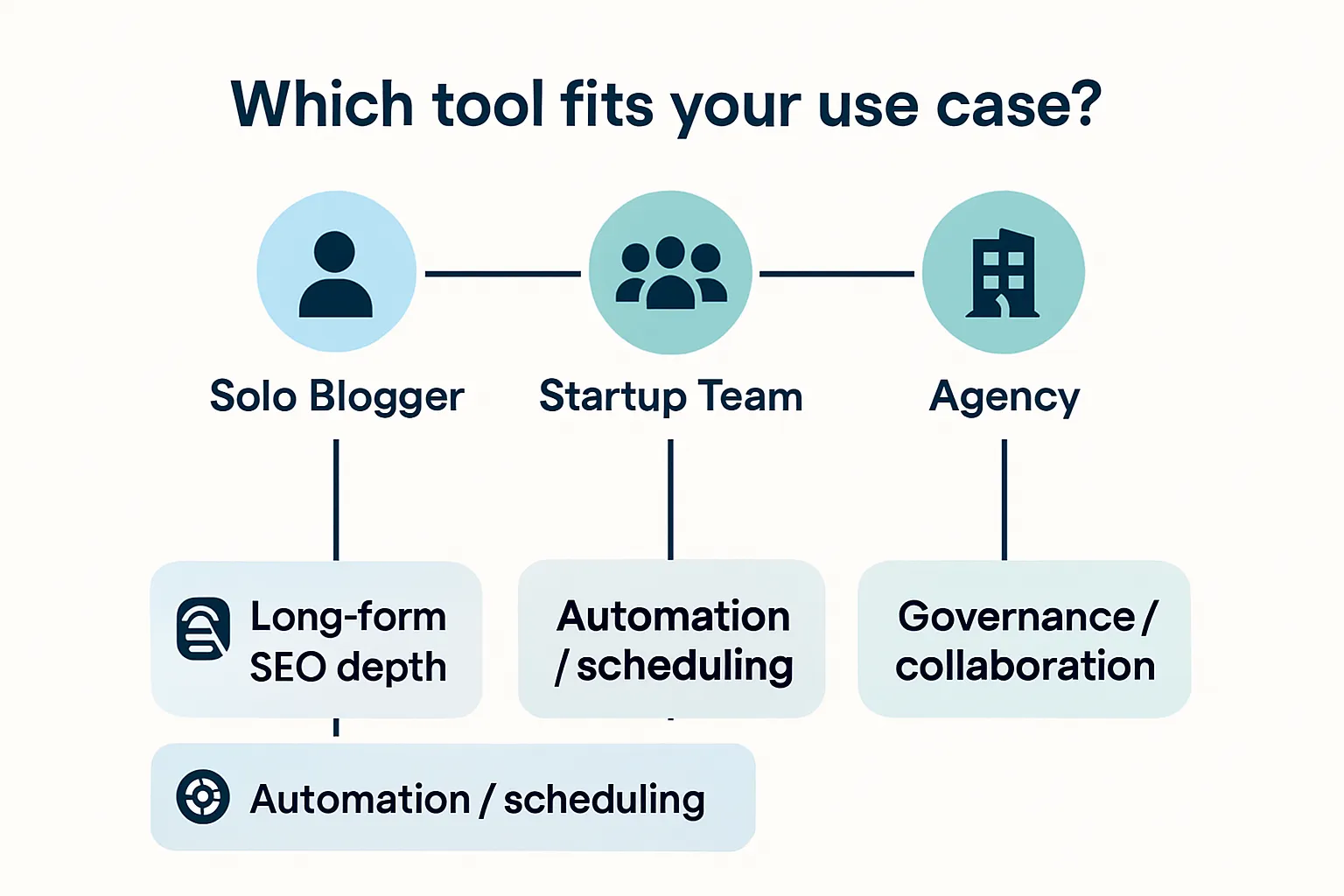
Quick decision guide
Solo creator vs team vs agency:
Solo: Prioritize built-in SEO guidance, automation, and affordability over advanced governance.
Team: Balance brand voice controls, collaboration, and steady SEO output.
Agency: Seek multi-workspace management, publishing automation, and API/extensibility.
SEO-first vs creativity-first:
SEO-first: SERP briefs, internal linking, metadata handling, and keyword clustering are must-haves.
Creativity-first: Emphasize outline flexibility, narrative flow tools, and strong rewriting/expansion.
Platform needs: drafting-only vs end-to-end publishing and analytics:
Drafting-only: Choose a writer with strong long-form editor and export options.
End-to-end: Consider a platform that adds hosting, analytics, newsletters, and multi-blog operations.
Blogbuster: What it is and who it’s for
Blogbuster is a specialized AI blogging tool designed to publish daily, SEO-optimized articles that rank and attract backlinks on autopilot. It’s built for teams that want a predictable, scalable content engine - without spinning up complex stacks. Typical outcomes include faster time-to-first-draft, a steady posting cadence, improved internal linking, and increased organic visibility across Google and AI search surfaces.
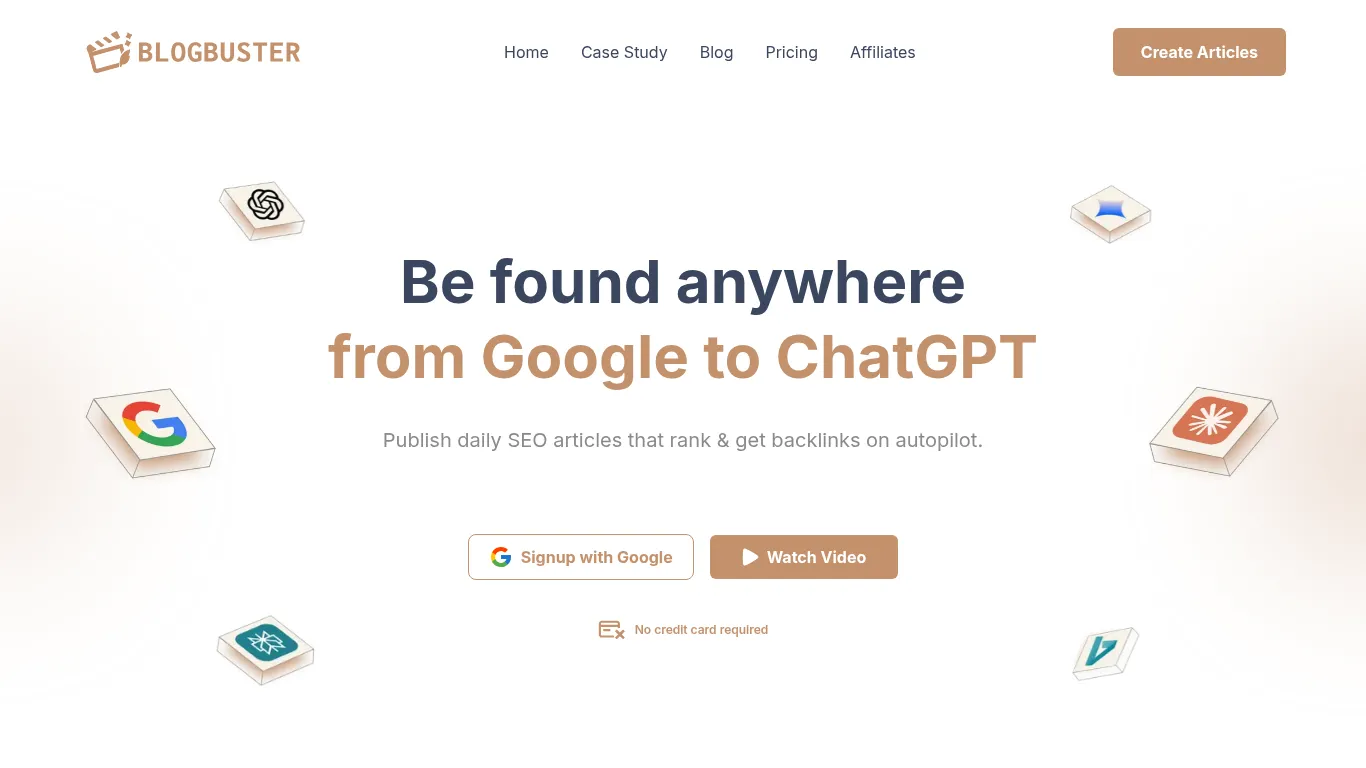
Core capabilities:
Long-form generation and outline control: Creates blog-length posts with human-like structure, including tables, bullets, and clear H2/H3 hierarchy; supports tone/style alignment via brand analysis.
SEO features: Generates briefs and recommended topics, inserts SEO keywords and metadata, and formats posts with on-page elements (titles, meta descriptions, schema-friendly structure).
Automation: Supports daily posting cadence, auto-internal linking to relevant site pages, and embeds custom visuals and illustrations for richer content.
Integrations: Publishes to WordPress, Shopify, Webflow, or via API; can host your blog directly; supports multi-language content for 40+ markets.
Strengths for long-form SEO blogging:
Purpose-built for SEO blogs with automated topic discovery, keyword suggestions, and internal linking.
Auto-backlink exchange to passively build authority.
Built-in editor for quick on-brand refinements and one-click publishing across CMSs.
Multi-project management to run several domains from a single dashboard.
Limitations to note:
Human review is still recommended for fact-checking and domain expertise.
Advanced SEO tool integrations beyond publishing/API may require external stacks.
Backlink exchange is automated but not a substitute for a full outreach program.
Ideal users and use cases:
Solo bloggers and founders who need steady, SEO-ready publishing without hiring writers.
Startup marketing teams seeking scalable, low-lift content operations across multiple sites.
Agencies managing multiple client blogs that need structured long-form output, internal linking, and scheduled publishing at volume.
Jasper AI: What it is and who it’s for
Jasper AI is a mature, enterprise-ready AI content platform built to help marketing teams create, govern, and scale on-brand content across channels. Typical outcomes include faster multi-asset production, stronger brand consistency, and streamlined collaboration across campaigns and markets.
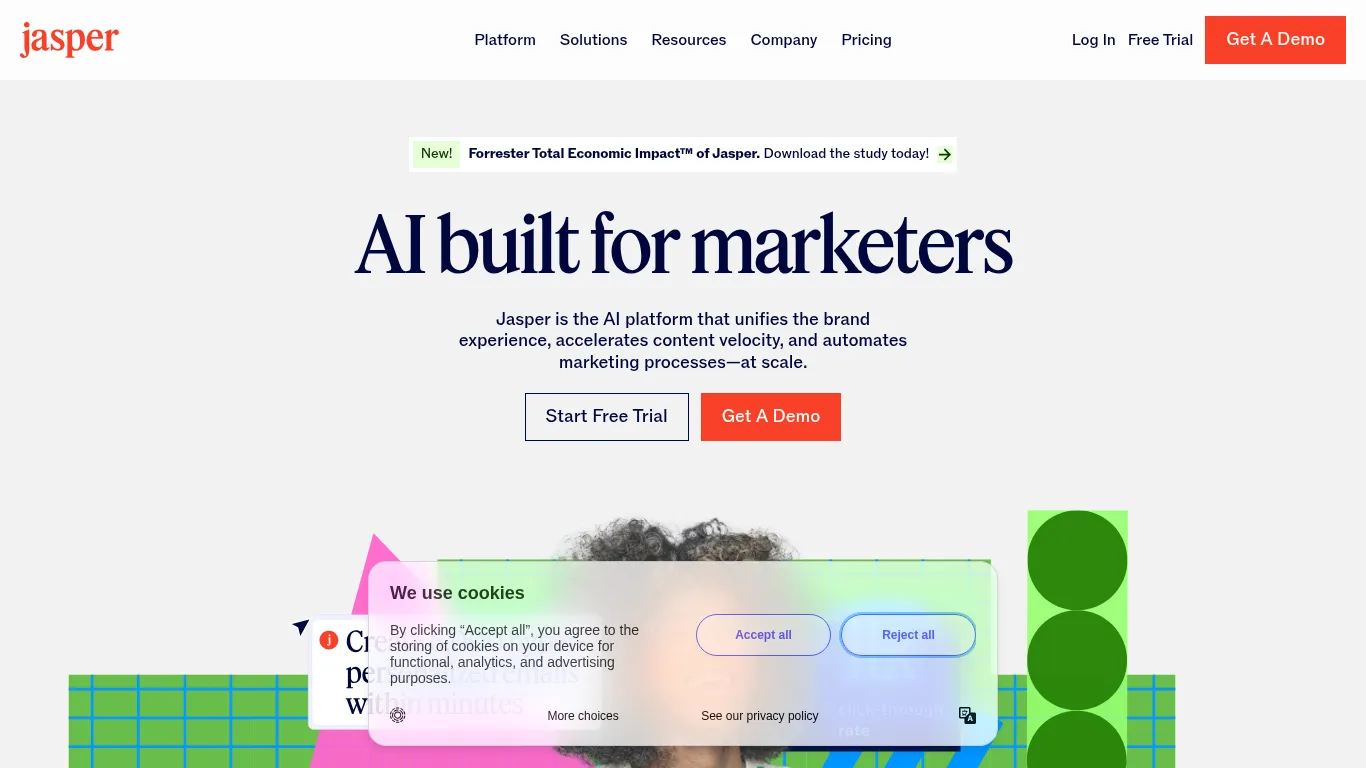
Core capabilities:
Long-form editor and templates: A robust Marketing AI Editor and a wide library of templates for blogs, ads, landing pages, and more - plus Canvas and App Library for structured planning and generation.
Brand Voice and style memory: Brand IQ, Voice, and Style Guide features bring consistent tone and visual guidance into every draft, with a knowledge base for deeper context.
SEO via integrations: SEO is supported through workflows, extensions, and partner tools; teams commonly connect to SEO platforms for keyword guidance and optimization.
Team collaboration and assets: Roles/permissions, shared assets, and agentic workflows (Agents, Canvas) enable review cycles, approvals, and repeatable processes at scale.
Strengths:
Breadth of templates and multi-channel use cases.
Powerful brand governance with voice, style, and knowledge context.
Mature UX for planning, creating, and collaborating across larger teams.
Limitations:
Cost can rise at scale with multiple seats and advanced features.
Full-stack SEO often relies on third-party add-ons and integrations rather than native tooling.
Ideal users and use cases:
Content teams and agencies producing diverse assets across multiple channels.
Established blogs that need brand-safe long-form plus campaign collateral.
Organizations that require governance, security, and integration depth alongside AI-assisted writing.
Writing Experience: Depth, control, and factuality
Outline-to-draft workflow
Blogbuster
Topic intake is fast: enter your domain, review recommended topics/briefs, and generate long-form drafts with pre-structured H2/H3 hierarchies, tables, and lists.
You can steer tone and style via brand analysis and light briefing, then refine in the built-in editor before auto-scheduling.
Strength is blog-first rigor: outline scaffolding, readability formatting, and SEO-minded sections are included by default.
Jasper AI
Starts with templates and Canvas planning to define goals, audiences, and structure before expanding into a full draft in the Marketing AI Editor.
Strong control over tone, POV, and length through Brand Voice, Style Guide, and knowledge context - useful when multiple teams must adhere to one strategy.
Ideal for multi-asset planning where long-form posts sit alongside landing pages, emails, and ads.
Practical tip:
Blogbuster: Seed the brief with 3–5 subheadings and 6–10 target entities/keywords; ask for a logical flow from problem → solution → examples to reduce rework.
Jasper: In Canvas, define audience, thesis, key talking points, and required CTAs; apply Brand Voice before drafting to enforce consistency.
Draft quality and factual grounding
Blogbuster
Produces coherent 2,000–3,000+ word structures with section-level scannability (bullets, tables, checklists).
Best output comes when you attach references (docs/URLs) the model can anchor to. Human fact-checking is still recommended for claims and industry stats.
Built-in SEO metadata and heading discipline minimize fluff, but SMEs should review nuanced sections.
Jasper AI
Leverages brand knowledge and style memory for more context-aware paragraphs; coherence across lengthy drafts is strong when Canvas inputs are specific.
For citations/statistics, teams usually pair Jasper with research workflows or external SEO/research tools; include source prompts to reduce generic claims.
Redundancy drops when drafts are guided by a detailed outline and audience intent within Canvas.
Practical tip:
Blogbuster: Append “Include 2 cited stats with sources and a summary box per section” to the brief to encourage grounded references.
Jasper: Use a “Fact block” prompt for each H2 (required sources + year) and run a second pass to replace generalities with specific data.
Brand voice and consistency
Blogbuster
Adapts to brand tone from your domain and prior content; solid for maintaining a consistent blog voice across posts and languages.
Works well for consistent, SEO-structured articles where tone alignment is important but governance is lightweight.
Jasper AI
Advanced governance via Brand Voice, Style Guide, and Brand/Marketing IQ; enforces word/phrase preferences and editorial rules across teams.
Excellent for organizations that need repeatable, on-brand execution across many writers and asset types.
Practical tip:
Blogbuster: Provide 2–3 exemplar articles; instruct “mirror tone and density” to tighten style match.
Jasper: Store voice rules and banned terms in Style Guide; apply them at draft time to prevent drift.
Editor UX and speed
Blogbuster
Built-in editor is geared for blog production speed: on-page elements, internal links, visuals, and one-click publishing/scheduling.
High throughput for daily cadence; ideal when the goal is consistent posting with minimal tooling hops.
Jasper AI
The Marketing AI Editor, Canvas, and agentic workflows provide a mature UX for planning, collaborating, and revising at scale.
Roles/permissions, shared assets, and context layers make multi-stakeholder reviews more efficient.
Practical tip:
Blogbuster: Use “auto-internal link suggestions” early, then lock the outline before content expansion to avoid re-linking.
Jasper: Draft in Canvas, then move to the editor for line edits and brand compliance checks; finalize with a short QA checklist for claims and links.
SEO Capabilities: From keyword to publish
Research and content briefs
SERP analysis and competitor outlines: Build briefs that reflect ranking page structures, common H2/H3s, and gaps you can fill. Pull “questions to answer” from People Also Ask and competitor FAQs to cover intent fully.
Keyword selection and clustering: Group related queries by intent (transactional vs informational), then map clusters to sections for topical authority. Prioritize primary keyword + 4–8 supporting entities per article for better semantic coverage.
On-page optimization while writing
Real-time SEO and structure: Keep headings consistent (H2 for sections, H3s for subsections), include target terms naturally, and draft meta title/description alongside the first draft.
Internal linking and structured data: Add internal links to cornerstone pages and recent posts; where applicable, add FAQ blocks and mark up with structured data. Optimize images with descriptive file names and alt text.
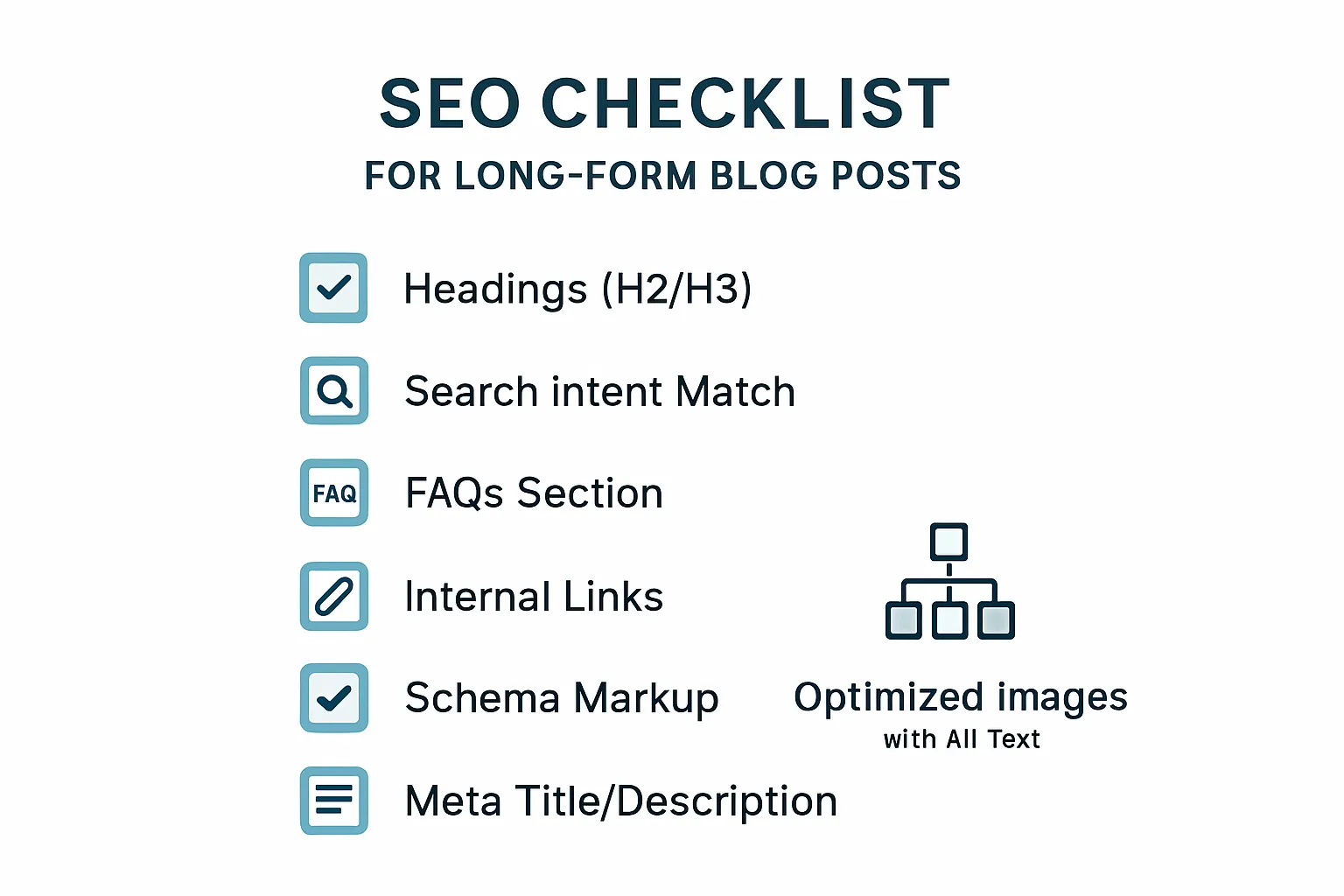
Post-publication workflows
Refresh cycles: Revisit high-value posts every 60–120 days to update stats, expand sections, and add new internal links. Watch impressions and CTR in Search Console to spot content decay and re-optimize headlines or intros.
Risk management
Balance and originality: Avoid over-optimization (keyword stuffing, repetitive anchors). Use credible sources, incorporate first-hand examples, and maintain author bios to support E-E-A-T.
"Create content for people, not search engines - demonstrate first-hand expertise and satisfy a specific audience." - Source
Workflow & Integrations: From draft to distribution
Templates and automation
Reusable briefs and calendars:
Blogbuster: Generates topic and keyword suggestions automatically, supports recurring series and daily publishing, and lets you save outlines for repeatable long-form formats.
Jasper AI: Uses Canvas and templates to standardize briefs across teams; agentic workflows can turn standard operating procedures into reusable playbooks.
Automated media and linking:
Blogbuster: Auto-injects internal links to relevant pages, adds custom visuals, and formats posts with tables, bullets, and listicles by default.
Jasper AI: Automates content assembly and cross-asset reuse; media handling typically follows your team’s asset library and production flow.
Scheduling and cadence:
Blogbuster: Auto-schedule daily/weekly posts per project and publish with one click to your CMS or hosted blog.
Jasper AI: Build content calendars via Canvas and automate handoffs and reviews; publishing timing is usually executed via your CMS or distribution stack.
CMS and tool integrations
CMS connections:
Blogbuster: Publishes to WordPress, Shopify, and Webflow, or via API; can also host your blog directly for an all-in-one setup.
Jasper AI: Connects to a broad integrations library and API, enabling ingestion from (and export to) your marketing stack and CMS of choice.
SEO and analytics hooks:
Blogbuster: Suggests topics/keywords and auto-optimizes on-page elements; supports internal linking and metadata, making it easy to plug into search workflows and monitor via your analytics stack.
Jasper AI: SEO is workflow-driven; teams often connect SEO tools and analytics to inform briefs, measure performance, and keep content aligned with strategy.
Multi-site and scale
Multi-workspace operations:
Blogbuster: Manage several projects/domains from one account; assign posting cadences and internal linking strategies per site.
Jasper AI: Organize multiple workspaces with shared brand voice and style guides; enforce consistency across regions, products, or lines of business.
Roles, approvals, and governance:
Blogbuster: Lightweight collaboration with a built-in editor for quick reviews before publishing.
Jasper AI: Robust roles/permissions, approval flows, and compliance guardrails to protect brand quality at scale.
Versioning and libraries:
Blogbuster: Centralized article management per project, with on-platform edits and quick republishing.
Jasper AI: Version control within a mature editor, shared asset libraries, and brand knowledge hubs to keep content discoverable and reusable across teams.
Teaming Up: Collaboration, compliance, and quality control
Collaboration and roles
Multi-author drafting: Assign sections or entire posts to contributors and centralize edits in one workspace.
Comments and approvals: Use inline comments, suggest-mode edits, and approval steps to keep reviews moving.
Status tracking: Standardize stages (Brief → Draft → Review → Approved → Scheduled) to align teams and reduce bottlenecks.
Governance and compliance
Brand voice guidelines: Store tone, terminology, and examples to enforce consistency across all long-form pieces.
Legal/regulated workflows: Route sensitive drafts through compliance reviewers; maintain audit logs and decision histories.
Content archives: Keep canonical copies, version diffs, and final assets to support reuse and audits.
Originality and fact-checking
Plagiarism and hallucination safeguards: Run originality checks and require sources for claims, stats, and definitions.
Citation prompts: Add per-section “required sources” and year constraints to anchor facts in current references.
Editorial checklists: Enforce a pre-publish QA list for accuracy, structure, and search readiness.
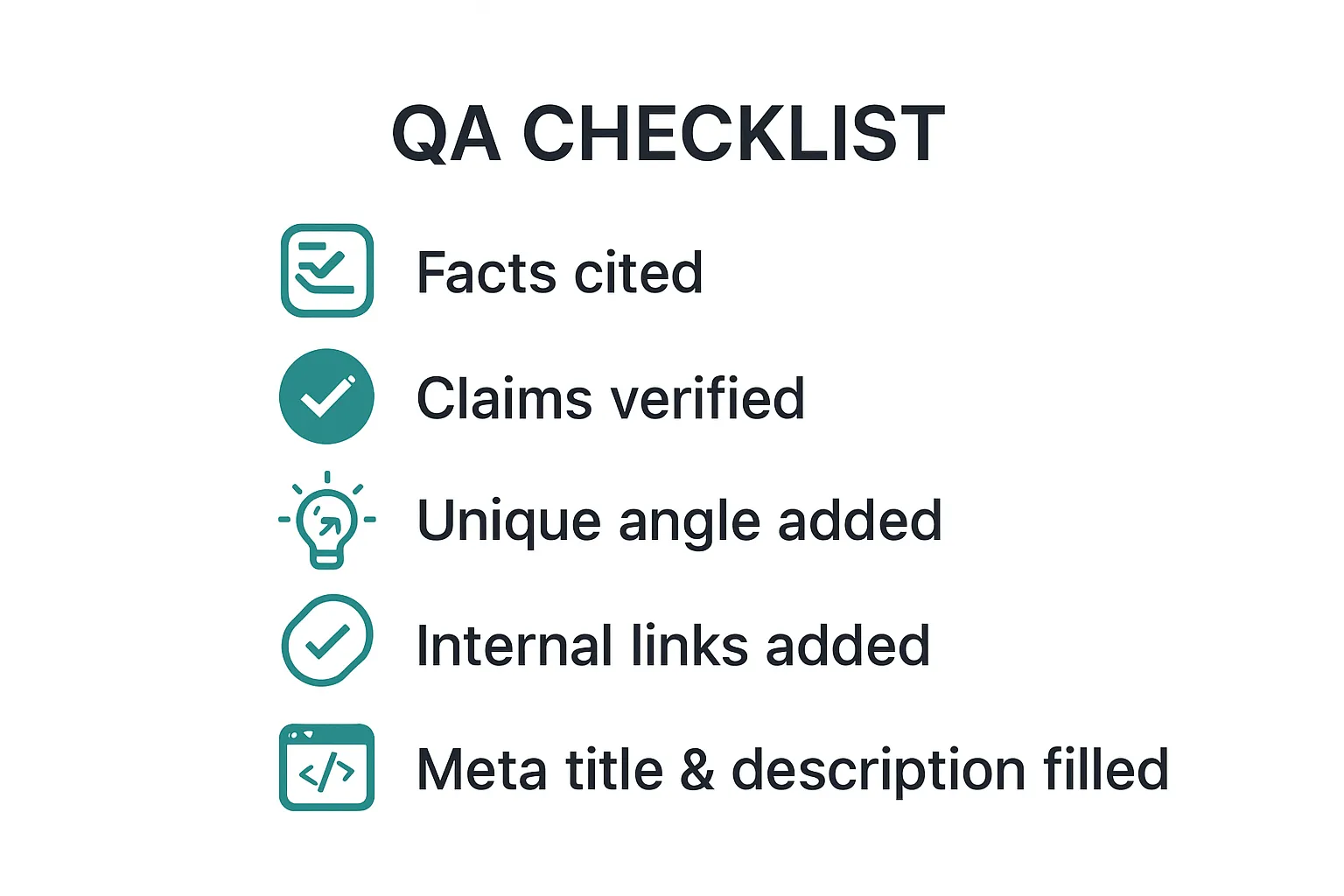
Pricing & TCO: What it really costs to run at scale
Transparent pricing overview
Entry plans and limits:
Blogbuster: tiered by monthly article volume (Starter 10, Growth 30, Booster 60), no per-seat pricing, free hosting option.
Jasper AI: seat-based licensing with a free trial; pricing is typically custom/enterprise for larger teams.
Word/credit limits: Blogbuster plans map to articles/month; Jasper AI usage is governed by seats/workflows and organizational policy.
Seats: Blogbuster does not charge per seat; Jasper AI cost scales with team size.
Add-ons you might need
SEO integrations: Many teams add a dedicated SEO tool (e.g., Surfer/Semrush) to Jasper AI; Blogbuster includes topic/keyword suggestions and on-page elements natively.
Plagiarism checks: Often added in Jasper-centric stacks; Blogbuster emphasizes unique generation but reviewers may still run checks.
Image generation: Blogbuster includes custom visuals in articles; Jasper offers an AI Image Suite or teams use external design tools.
API: Both offer API routes; cost varies by usage and plan.
Scenario-based cost math
Solo blogger (4 posts/month): Prioritize low lift and included SEO basics over complex stacks.
Startup team (12 posts/month): Balance predictable cadence, on-page SEO, and light collaboration.
Agency (40+ posts/month, multi-client): Multi-site management, scheduling, and governance drive ROI.
Scenario | Posting Volume & Seats (Assumptions) | Blogbuster Plan & Expected Monthly TCO | Jasper AI Expected Monthly TCO (Est.) | Key Considerations |
|---|---|---|---|---|
Solo blogger | 4 posts/month, 1 seat | Starter ($18.90) | $120–$200 | Jasper stack often includes 1 seat + SEO tool (+ plagiarism/images). Blogbuster bundles on-page SEO, internal links, and visuals. |
Startup team | 12 posts/month, 3 seats | Growth ($49.90) | $350–$800 | Jasper cost grows with seats and add-ons; Blogbuster’s volume-based plan covers cadence with no seat fees. |
Agency | 40+ posts/month, 10 seats, multiple sites | Booster ($79.90+) or enterprise for higher volumes | $1,200–$3,000+ | Jasper excels for governance at scale; Blogbuster maximizes output per dollar for high-volume SEO blogs; agencies may choose Blogbuster enterprise for more sites/volume. |
Value-for-money verdict
Solo blogger: Blogbuster delivers the lowest TCO for consistent, SEO-ready posts and simple publishing; Jasper is overkill unless you need multi-channel assets and brand governance.
Startup team: Blogbuster’s Growth plan offers strong ROI if your focus is long-form SEO blogging; Jasper wins when your team also needs ads, landing pages, and centralized brand controls.
Agency: For high-volume SEO blogging across clients, Blogbuster’s automation and volume pricing are cost-efficient. Jasper provides deeper governance and cross-channel breadth - higher TCO but stronger for complex, multi-asset workflows.
Final Verdict: Which one should you choose?
If you’re a solo blogger prioritizing speed-to-quality: Blogbuster wins. Its blog-first automation (daily posting, internal linking, topic/keyword suggestions, and built-in visuals) keeps TCO low and output consistent with minimal setup.
If you’re a small team needing brand voice plus SEO: Jasper AI wins. You’ll get mature brand governance (Brand Voice, Style Guide, knowledge context), strong collaboration, and repeatable workflows; pair with an SEO tool to round out optimization.
If you’re an agency producing at scale: It depends on your model.
For cross-channel, governed content and multi-team coordination: Jasper AI.
For high-volume, SEO-focused blog production across many sites at the lowest TCO: Blogbuster.
Where each tool clearly wins
Blogbuster:
Long-form SEO workflows where structure, internal links, and daily cadence matter most.
Teams that want “ideas → draft → on-page optimization → publish” in one streamlined flow.
Multi-site blogging with lightweight collaboration, auto-scheduling, and volume pricing.
Jasper AI:
Brand voice governance across many asset types (blogs, landing pages, emails, ads).
Teams needing roles/permissions, approvals, and shared asset libraries at enterprise depth.
Complex, multi-channel campaigns where content must stay on-message across regions and teams.
Alternative to consider: platform-level publishing
If you want end-to-end blogging - AI writing plus hosting/templates, analytics, newsletters, and internal-linking automation - consider BlogBowl. It’s an all-in-one platform built for SaaS and digital businesses that:
Launches a fast, SEO-optimized blog in under 60 seconds
Automates daily SEO content, keyword research, internal linking, and embedded media
Includes built-in analytics and newsletter tools
Supports multi-blog management and custom domains
Explore BlogBowl to simplify your entire content stack and focus on audience growth instead of tool orchestration.
FAQs
Can I publish AI-generated long-form content without editing?
It’s risky. Always run a human pass for factual accuracy, tone, and a unique point of view. Verify stats and claims, add first-hand context (screenshots, examples, quotes), and ensure the introduction, transitions, and CTA match your brand and offer.
Do I still need an SEO tool if the writer has ‘SEO mode’?
Sometimes. Built-in suggestions are fine for low-competition topics and fast turnarounds. For competitive SERPs or strategic pages, use SERP-grade analysis (query intent, competitor gaps, entity coverage, internal link opportunities) and validate with analytics and Search Console.
How do I keep outputs original across dozens of posts?
Use a consistent prompt framework (audience, thesis, outline, required sources, CTA).
Store brand voice/tone rules and enforce them per draft.
Inject proprietary data (case studies, metrics, quotes) and niche examples.
Rotate structures (how-to, comparison, teardown, FAQ) and vary intros.
Maintain an editorial SOP: uniqueness checks, redundancy reduction, and “what’s new” sections for each piece.
What metrics should I track post-publish?
Rankings and impressions (query-level), CTR, dwell time/scroll depth, conversions, and backlinks.
Set refresh triggers: traffic or rankings down 20–30%, declining CTR, outdated stats, new competitors. Re-optimize headings, add internal links, and update examples every 60–120 days.
How do these tools fit with platform solutions?
Drafting in an AI writer: Flexible and model-agnostic, ideal if you already have a CMS and SEO stack. You’ll manage more integrations and approvals.
End-to-end platform: Choose an all-in-one solution like BlogBowl if you want AI writing plus hosting/templates, analytics, newsletters, internal linking automation, and multi-blog management - fewer moving parts, faster operational speed.


